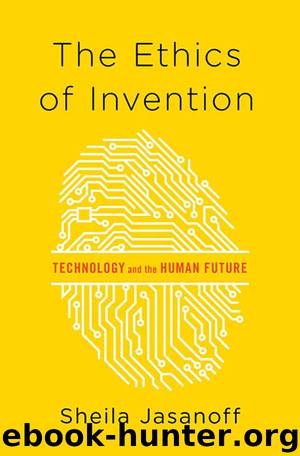The Ethics of Invention by Sheila Jasanoff

Author:Sheila Jasanoff
Language: eng
Format: epub
Publisher: W. W. Norton & Company
NEW VULNERABILITIES
Digital traces of persons differ from physical ones in ways that make it more problematic and less useful to draw straightforward analogies with physical persons or spaces. First, there are novel issues of individual autonomy. “Big data” have become big business in the era of Web 2.0 in part because large data sets allow access to hitherto secluded features of human thought and intention. Digital data from countless online interactions can be aggregated and grouped to build remarkably accurate, composite pictures of a person’s identity, attitudes, and behaviors; data allow access not just to that person’s body or appearance but to the thinking and acting self within. Second, digital information is reciprocal, raising new questions about privacy: persons not only put data about themselves onto the World Wide Web but, through those acts, also become potential subjects for surveillance, commerce, and even experimentation. And as people and their actions are hooked up to myriad data collection devices in the Internet of things, they also become traceable as never before. Third, unlike physical movements, informational traces are lasting, some might say unforgiving and even accusatory. They persist through time, sedimenting histories that are less amenable to personal control or erasure than lives lived in the predigital era. All three dimensions allow outsiders access to aspects of the personality that could not be deduced from physical traces alone; all three present dilemmas for ethics and law.
The Internet has become an informational quarry. Examples of people being tracked, or tracked down, through publicly available information are legion. A striking example, a first of its kind, dramatized the inroads such data allow into presumed zones of privacy. Sometime in late 2004, a fifteen-year-old boy conceived with sperm from an anonymous donor set out to find his genetic father. He “rubbed a swab along the inside of his cheek, popped it into a vial and sent it off to an online genealogy DNA-testing service.” Nine months later, for a fee of $289, the service identified two persons with closely matching DNA who revealed themselves to the boy as likely near-relatives. Using their shared last name and the father’s place and date of birth, which he knew from his mother, the boy then bought from an Internet genealogical service a list of persons meeting all of his criteria. One person on the list had the right last name, and so the boy finally had his answer. The man had never donated his DNA to a database or consented to having his identity as sperm donor made public; nonetheless, a fifteen-year-old’s ingenuity and persistence outed him, at very little cost to the inquirer. “The case shows,” said a Canadian bioethicist, “that there are ethical and social concerns about assisted reproduction that we did not think about.”9 The comment characteristically recasts the privacy breach as an unintended consequence, but of course the easy availability of data is a conscious design feature, not a bug, one of the attributes fought for and prized by the originators of cyberspace.
The fifteen-year-old used ingenious common sense to find his father.
Download
This site does not store any files on its server. We only index and link to content provided by other sites. Please contact the content providers to delete copyright contents if any and email us, we'll remove relevant links or contents immediately.
| American National Standards Institute (ANSI) Publications | Architecture |
| History | Measurements |
| Patents & Inventions | Research |
Whiskies Galore by Ian Buxton(40332)
Introduction to Aircraft Design (Cambridge Aerospace Series) by John P. Fielding(32338)
Small Unmanned Fixed-wing Aircraft Design by Andrew J. Keane Andras Sobester James P. Scanlan & András Sóbester & James P. Scanlan(32141)
Craft Beer for the Homebrewer by Michael Agnew(17447)
Turbulence by E. J. Noyes(7039)
The Complete Stick Figure Physics Tutorials by Allen Sarah(6638)
Kaplan MCAT General Chemistry Review by Kaplan(6054)
The Thirst by Nesbo Jo(5786)
Bad Blood by John Carreyrou(5769)
Learning SQL by Alan Beaulieu(5412)
Weapons of Math Destruction by Cathy O'Neil(5037)
Man-made Catastrophes and Risk Information Concealment by Dmitry Chernov & Didier Sornette(4736)
iGen by Jean M. Twenge(4702)
Digital Minimalism by Cal Newport;(4543)
Life 3.0: Being Human in the Age of Artificial Intelligence by Tegmark Max(4508)
Audition by Ryu Murakami(4099)
1,001 ASVAB Practice Questions For Dummies by Powers Rod(4039)
Electronic Devices & Circuits by Jacob Millman & Christos C. Halkias(4029)
Pale Blue Dot by Carl Sagan(4001)
